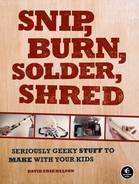If any single man is responsible for launching a thousand electronic tinkerers, it’s Forrest M. Mims III. RadioShack has sold his clear, readable, and cheap Engineer’s Mini Notebook series for decades. Getting Started in Electronics, as the title implies, is a great place to start. In addition to providing a solid framework for both the practical skills and theoretical foundations of electronics, the book also offers 100 neat, easy-to-build circuits. Mims’s website can be found at http://www.forrestmims.org/.
When buying components online, most folks go with either Digi-Key (http://www.digikey.com/) or Mouser Electronics (http://www.mouser.com/). Mouser is often slightly cheaper, but Digi-Key offers the cheapest shipping options as of this writing. I’ve never ordered from Jameco Electronics (http://www.jameco.com/), but they come fondly recommended by friends and colleagues, and have an easily navigable website. Alternatively, you can use a tool like Octopart (http://octopart.com/) to track down the absolute cheapest component prices. On the other hand, if you live close to a RadioShack, you might want to stop in: Although these parts are usually more expensive, you can often get common components (such as those used throughout this book) right away.
Once you’ve built a couple of the electronics projects in this book, you’re perfectly qualified to build any of the supercool kits sold by Adafruit Industries (http://www.adafruit.com/), MAKE magazine’s Maker SHED (http://www.makershed.com/), SparkFun Electronics (http://www.sparkfun.com/), and Evil Mad Science (http://evilmadscience.com/).
Keep an eye out for neat components that you might use for future projects of your own. Check the American Science & Surplus website (http://www.sciplus.com/), garage sales, resale shops, and freecycle groups.
